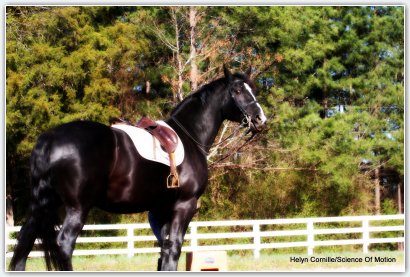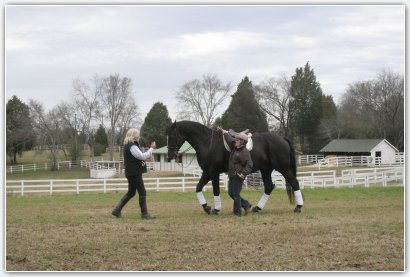Mechanicalresponsiveness PT 11
Mechanoresponsiveness
Part 11
Inverse Dynamics
Jean Luc Cornille

“There is another world, but it is in this one”. (William Butler Yeats)
For two or three millennia, visual examination has been the main clinical tool for diagnosis of lameness, quality of the gaits or athletic predispositions of the horse. In the last two decades, kinematics or kinetics analysis respectively have enhanced our understanding of the gaits. However, variables such as limb trajectories, joint angles and angular velocities contain basically the same information that is observed by the eye of an experienced breeder or trainer. A more powerful method is analyzing movements and forces simultaneously using Newton’s law of dynamics.
Riding and training and performing is not postural. It is about producing and managing forces. Without force production, (motion), there is no forces management and when poor force management, (dysfunction), causes injury, only recreating proper function of the horse’s physique and therefore proper motion, can restore soundness. The promise is great. Many injuries can be prevented. Many “irreversible’ damages in the view of conventional approaches, can be reversed. Many resistances of the horse and difficulties to perform can be amended. There is another world and a much better world but it is in this one. It demands the evolution from superficial thinking and acting, to deep respect for the horse, respect for the students and therefore a training and a teaching updated to actual knowledge.
John Naisbitt wrote, “We are drowning in information but starved for knowledge.” In a world where marketing prevail, science is used as a selling tool and theories are promoted claiming scientific reference even when such references are partial and largely distorted to benefit the product or riding or training tool that promoters want to sell. There have been recently the promises that the hyoid apparatus was acting on the horse back and that the lowering of the neck was producing endorphins. In a more serious study, “Understanding the perceptual world of the horse” Carol A. Saslow explains that the release of opoid neurochemicals called “endorphins” occurs whatever the neck posture. An interesting observation is that, “the highest level of beta-endorphin occurs in early morning and correlates with decrease nociceptive (pain) sensitivity at that time.” Perhaps, in order to be more accurate, promoters of the low neck/endorphins theory should advise lowering the neck between 6.05 and 7.14 am.
Isaac newton (1642-1727), formulated the basic law of dynamics establishing a relationship between force, mass and translational movement. The laws of dynamics allow predicting and measuring motion when the intensity of the force is known. This is referred to as (forward dynamics). At the contrary, (inverse dynamics) is about estimating the forces that were the cause of an observed motion. Proponents of superficial equitation will rise their eyeballs thinking, “How this is going to make me win a blue ribbon?” It will not but it might prevent the horse form injury barring the horse from any performance.
In humans for instance, a very well-known finding is that knee extensor moments during gait are significantly reduced after anterior cruciate ligament injury. Inverted dynamic analysis provides a tool to monitor patient progresses during rehabilitation. This type of practice is not commonly used in equine rehabilitation, but the results of these studies support the main concept of the science of motion’s rehabilitation technique that can be resume into the formula “Perfect hoof placemen”. The formula is not limited to the hoof; this just a paraphrase. The therapy is about creating perfect placement of the joint or alignment of the joints at impact and during the stance. In human rehabilitation, a certain bracing method reduces the medial compartment load on the knee joint. The human knee is the horse stifle and applying the findings, we have observed that perfect stifle placement at impact and during the support phase accelerated the horse’s rehabilitation.
Manchester had severe damage on the anterior cruciate ligament of the left stifle. It is by applying this technique that we restored soundness. We used him as a school horse for our teaching program once he was sound and he kept in the heart and the mind of each student who rode him, the memory of a very powerful and very kind horse.  He is 18,2 and weighs 1800 pounds. He also left in the senses of every student, the feeling of absolute lightness on the bit, on the legs, on the seat and very high suspension. Superficial thinking will theorize that we manipulated the joint or the leg as this is the way the equestrian world is used to think. There is a better world but it is deeper. “The biomechanics of the vertebral column, although very complex, are of vital importance because they form the basis of all body movement”. (Leo Jeffcott, Natural rigidity of the horse’s back bone, 1980). Proper placement of the stifle joint at impact and during the stance depends directly on functional or dysfunctional mechanism of the vertebral column.
He is 18,2 and weighs 1800 pounds. He also left in the senses of every student, the feeling of absolute lightness on the bit, on the legs, on the seat and very high suspension. Superficial thinking will theorize that we manipulated the joint or the leg as this is the way the equestrian world is used to think. There is a better world but it is deeper. “The biomechanics of the vertebral column, although very complex, are of vital importance because they form the basis of all body movement”. (Leo Jeffcott, Natural rigidity of the horse’s back bone, 1980). Proper placement of the stifle joint at impact and during the stance depends directly on functional or dysfunctional mechanism of the vertebral column.
Manchester was dysfunctional as he traveled with a strong right lateral bending that was coupled with an inverted rotation. The spine dysfunction placed the pelvis in an oblique posture altering proper kinematics of both hind limbs. The left stifle was weaker and the damaged started there. Whatever treatment was done was ineffective as long as the scoliosis of the thoracic spine and the muscular imbalance creating inverted rotation was identified, addressed and corrected. The horse was lame for eight years before he came to us. Nothing worked because the same stress damaged the same ligament as soon as the horse was set in motion.  Working hip or knee extensors muscles did not work either for a reason that only Inverse dynamics analysis permit to understand. “Even more so that human, the horse, which is four multi-jointed limbs frequently acting as close-chain mechanisms, may redistribute its joint movements without visual gait changes. For instance, a visually identical hind limb extension in late stance may be accomplished by only hip extensors muscles, only knee extensor muscles or any combination of these. Inverse dynamic analysis allows to ‘see’ these differences in muscle coordination” (Liduin S, Meershoek and Anton J. van den Bogert. Mechanical Analysis of Locomotion, 2003)
Working hip or knee extensors muscles did not work either for a reason that only Inverse dynamics analysis permit to understand. “Even more so that human, the horse, which is four multi-jointed limbs frequently acting as close-chain mechanisms, may redistribute its joint movements without visual gait changes. For instance, a visually identical hind limb extension in late stance may be accomplished by only hip extensors muscles, only knee extensor muscles or any combination of these. Inverse dynamic analysis allows to ‘see’ these differences in muscle coordination” (Liduin S, Meershoek and Anton J. van den Bogert. Mechanical Analysis of Locomotion, 2003)
We did not have, at the farm, the capacity of inverse dynamics analysis. The software is available in vet school research programs and it is a very complex mathematical work. Only specialized experts can complete such work. However, watching over and over kinematics analysis of the stifle and results of inverse dynamics, it became possible to develop an eye for proper stifle movement. The feeling was also a major asset. Our therapy is always done in motion combining in hand work and riding. The combination of visual impression and physical perception provides a better ground for sound analysis. The first part of the rehabilitation focused on correcting the back muscles dysfunction. It was done riding the horse using different level of balance, straightness and exercises. Once sound alignment and functioning of the thoracolumbar spine was recreated, the work refined the mechanics of the vertebral column until thoracolumbar motion, pelvis motion and consequently stifle motion became correct.
It was a lot of try and think and try again and Manchester’s participation was superb. At first he reacted protecting his problem like every horse does and even more when the horse has developed a long habit of protective reflex mechanism. Once Manchester explored a specific flexion of the thoracic spine that changed the angle of the pelvis and consequently the stifle alignment, the work took a different dimension. As I felt the reaction and ease of the left stifle, I was thinking about the human study talking about a certain bracing method reducing the medial compartment load on the knee joint. I probably had created the same phenomenon with the horse.
I approach the next day training session hoping that I could recreate the same proper alignment. Manchester has done his homework too. His psychology was no longer protecting his stifle but letting me guiding him toward the proper coordination. Therapy in motion is not about moving a joint. It is about creating an overall body coordination allowing proper use of the joint during the many situations that are related to motion. This cannot be done without active participation of the horse’s intelligence. There is a lot to say about that because before finding the right coordination, the horse does errors and if the horse became afraid of error because error engenders reprimand, the horse never explores beyond natural reflexes, which are protecting the problem and not addressing and correcting it.
There is another world but it is in this one. It is deeper than the superficial world that we are trained to see and believe. It demands a higher level of thinking. During Manchester rehabilitation, I had the rational thought that if I walked backward during the in hand work, I could see the stifle. Rational but simplistic. It was proper functioning of Mancheser’s thoracolumbar spine that create perfect stifle placement at impact and during the stance. By facing the back, my back was not working properly and Manchester became confused. The in hand work that we do has nothing to do with the type of in hand work commonly promoted. Our approach is inspired by general Decarpentry work in hand but adapted to actual knowledge. We do not use obedience and conditioned reflexes such as the whip touching the horse chest. We use the fact that when trained to do it, horses are capable to perceive the energy that the rider creates through nuances in tone of abdominal and back muscles.
We do not work between the hands and the whip, which can only teach gestures. We work back to back. Once the horse is in tune with the rider’s back, it became possible to create greater sophistication of the horse’s thoracolumar mechanism. This is of course a gross simplification. The work is very precise, very sophisticated and immensely interesting. Facing the back did not allow subtle work and coordination of my own back and abdominal muscles and Manchester did not feel the dialogue anymore. It was logical for the superficial world to look at the stile. It was disturbing for the other world, the one where the horse is comfortable to live in. Jean Luc


 twitter
twitter facebook
facebook google
google stumbleupon
stumbleupon pinterest
pinterest linkedin
linkedin